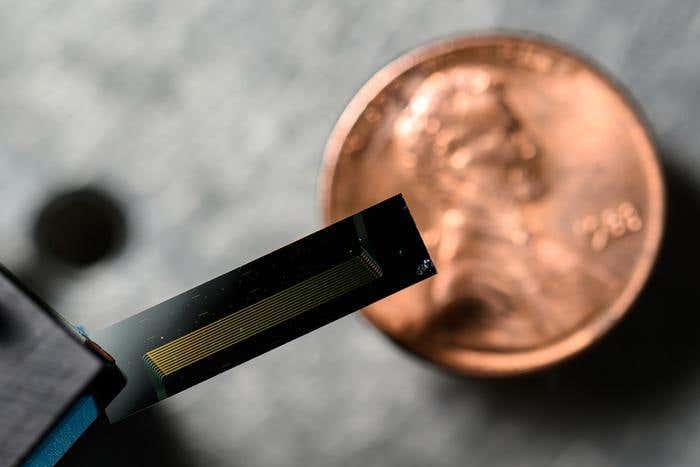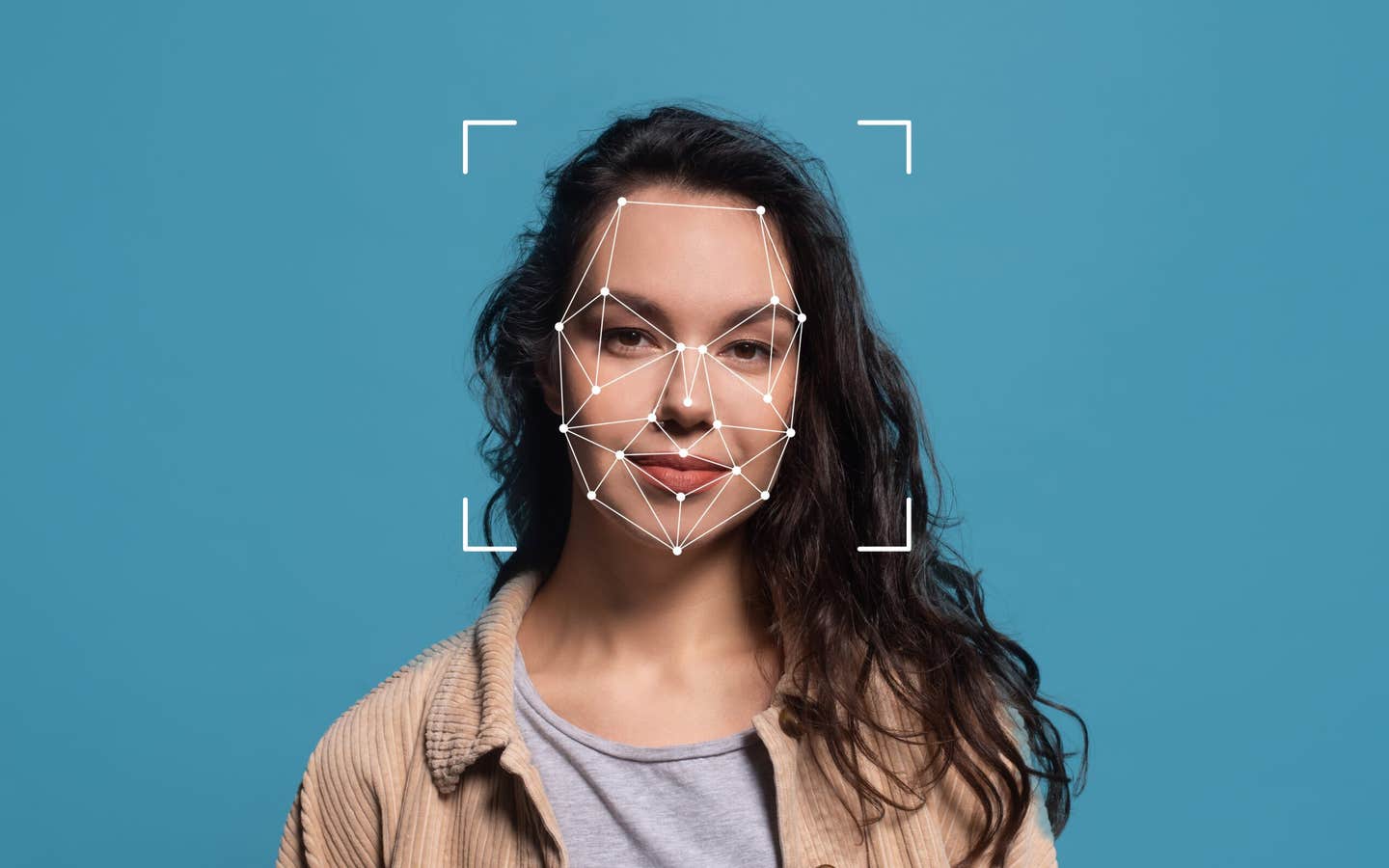Tiny laser revolutionizes precision measurement and self-driving technology
A laser smaller than a penny could soon power LiDAR in self-driving cars, optical clocks, and space tools, thanks to new chip-scale tech.

A chip-scale laser from UC Santa Barbara and Rochester may transform LiDAR, clocks, and quantum sensing with record-setting precision. (CREDIT: University of Rochester photo / J. Adam Fenster)
Scientists from the University of Rochester and UC Santa Barbara have built a laser so small it can sit on a penny. But don’t let its size fool you. This tiny laser could power the next generation of self-driving cars, space science tools, and high-precision clocks.
Published in the journal, Light Science & Applications, the new laser is part of a field called optical metrology, which uses light to measure things. Light-based measuring is incredibly accurate and doesn’t require physical contact. That’s why it’s used in everything from mapping the surfaces of planets to detecting gravitational waves—the tiny ripples in space that happen when black holes collide.
The catch? Most of today’s lasers that are used in metrology are large, expensive, and require a lot of extra gear to work. That limits where and how we can use them. This new chip-scale laser changes that.
Instead of relying on bulky machines, the chip laser uses a synthetic crystal called lithium niobate. This material changes how light moves through it when electricity is applied. The effect is called the Pockels effect, and it’s the key to the laser’s incredible performance.
Changing the Game in Speed and Precision
This new laser can change its light frequency at a rate of 20 quintillion times per second. That’s a 2 followed by 19 zeros. No other laser has done this before at this speed and accuracy.
It also has an extremely narrow linewidth—just 167 Hz. That means the laser’s light is very pure and stable, which is important for making exact measurements. It can adjust across a frequency range of 24 gigahertz without skipping over any frequencies. That’s more than 10 times better than many current systems.
To get all this in a tiny chip, the scientists used a design called a Pockels laser. They combined an indium phosphide gain chip with a lithium niobate photonic circuit. This circuit acts as the laser’s external cavity—basically, the part that controls the laser beam. They added reflectors made of silicon oxide, carefully etched to control the light with great precision. By placing tuning electrodes along the chip, they could quickly adjust the laser’s frequency with electricity.
Related Stories
Shixin Xue, a PhD student at Rochester who helped design the laser, explained the excitement around the project:
“There are several applications we are aiming for that can already benefit from our designs. The first is LiDAR.”
How It Works in Real Life
LiDAR is short for light detection and ranging. It’s what self-driving cars use to map the road and spot obstacles. But the most advanced version of LiDAR—called frequency-modulated continuous-wave LiDAR—needs a laser that can change its frequency fast and smoothly. That’s exactly what this chip laser can do.
In one test, the team mounted the laser on a spinning disc and used it to read LEGO blocks shaped like the letters “U” and “R.” This was a small demonstration, but it shows how the laser could be scaled up to detect cars and other obstacles at high speeds.
In another experiment, they tested a technique called velocimetry, which measures how fast something is moving. They were able to detect speeds up to 40 meters per second at a distance of only 0.4 meters. That’s something no current LiDAR system can do with such accuracy.
They also achieved distance measurements with a precision of under 2 centimeters and even locked the laser to a reference gas cell without needing all the usual large equipment. This process, called Pound-Drever-Hall locking, is commonly used in optical clocks and quantum sensors.
“It’s a very important process,” said Xue. “But you need a lot of equipment to do that. Our laser can integrate all of these things into a very small chip that can be tuned electrically.”
What It Could Mean for the Future
The chip laser offers more than just compact design. Its power and flexibility make it suitable for many fields. Autonomous cars, quantum computing, advanced manufacturing, and even deep-space research could benefit.
In gravitational wave detection, for instance, scientists need lasers that are extremely stable and precise. Even tiny changes in laser frequency can affect the data. A chip-sized laser that can maintain long-term frequency stability—with only ±6.5 megahertz of fluctuation over an hour—would be a game changer.
In the world of optical clocks, which are used to measure time with incredible accuracy, the chip laser could shrink machines that now take up entire desks into something much smaller and more portable.
The research team even hinted that this breakthrough could help measure dark matter or improve quantum sensors used in national defense and health technologies.
The work was funded by DARPA’s LUMOS program and the National Science Foundation. Both agencies are known for supporting cutting-edge tech with military and scientific value.
How It Works Under the Hood
The design behind the laser is just as impressive as its performance. Traditional lasers often rely on ring resonators or external modulators that must be finely tuned. These systems are vulnerable to small errors during production.
The chip laser solves this by using an extended distributed Bragg reflector (eDBR). Instead of putting this reflector in the lithium niobate layer, the researchers etched it into the surrounding silicon oxide layer. This allowed them to control the strength of light reflection more easily and achieve cleaner, more stable output.
They also added a phase shifter using electrodes that run along the chip. When voltage is applied, the Pockels effect shifts the light’s path, helping fine-tune the laser’s frequency. The laser operates at around 1555 nanometers, which is the same range used in many telecom systems. It produces about 13 milliwatts of optical power and can maintain single-mode lasing with minimal noise.
At all modulation speeds up to 1 gigahertz, the laser responded to electrical signals accurately. Even when driven at very high speeds, the change in frequency stayed close to ideal. Its tuning efficiency held strong up to 2 gigahertz and only started to drop off slightly after that.
One of the standout results was a chirping rate of 2×10¹⁹ Hz/s. When compared to other top-performing lasers, this chip laser outperforms them in both tuning speed and range.
At a modulation frequency of 100 megahertz, the chip achieved a frequency range of 24 gigahertz. That’s an order of magnitude better than past designs. The researchers believe this jump came from the tight coordination between the laser’s phase shifter and its Bragg reflector at this frequency range.
Note: The article above provided above by The Brighter Side of News.
Like these kind of feel good stories? Get The Brighter Side of News' newsletter.
Shy Cohen
Science & Technology Writer



